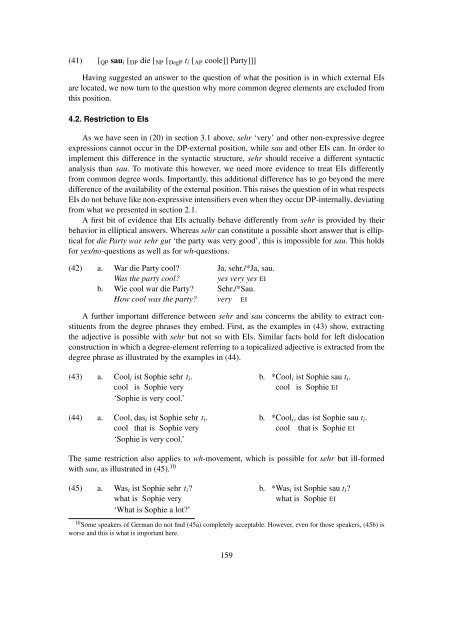Empirical Issues in Syntax and Semantics 9 (EISS 9 ... - CSSP - CNRS
Empirical Issues in Syntax and Semantics 9 (EISS 9 ... - CSSP - CNRS
Empirical Issues in Syntax and Semantics 9 (EISS 9 ... - CSSP - CNRS
You also want an ePaper? Increase the reach of your titles
YUMPU automatically turns print PDFs into web optimized ePapers that Google loves.
(41) [ QP sau i [ DP die [ NP [ DegP t i [ AP coole]] Party]]]<br />
Hav<strong>in</strong>g suggested an answer to the question of what the position is <strong>in</strong> which external EIs<br />
are located, we now turn to the question why more common degree elements are excluded from<br />
this position.<br />
4.2. Restriction to EIs<br />
As we have seen <strong>in</strong> (20) <strong>in</strong> section 3.1 above, sehr ‘very’ <strong>and</strong> other non-expressive degree<br />
expressions cannot occur <strong>in</strong> the DP-external position, while sau <strong>and</strong> other EIs can. In order to<br />
implement this difference <strong>in</strong> the syntactic structure, sehr should receive a different syntactic<br />
analysis than sau. To motivate this however, we need more evidence to treat EIs differently<br />
from common degree words. Importantly, this additional difference has to go beyond the mere<br />
difference of the availability of the external position. This raises the question of <strong>in</strong> what respects<br />
EIs do not behave like non-expressive <strong>in</strong>tensifiers even when they occur DP-<strong>in</strong>ternally, deviat<strong>in</strong>g<br />
from what we presented <strong>in</strong> section 2.1.<br />
A first bit of evidence that EIs actually behave differently from sehr is provided by their<br />
behavior <strong>in</strong> elliptical answers. Whereas sehr can constitute a possible short answer that is elliptical<br />
for die Party war sehr gut ‘the party was very good’, this is impossible for sau. This holds<br />
for yes/no-questions as well as for wh-questions.<br />
(42) a. War die Party cool? Ja, sehr./*Ja, sau.<br />
Was the party cool? yes very yes EI<br />
b. Wie cool war die Party? Sehr./*Sau.<br />
How cool was the party? very EI<br />
A further important difference between sehr <strong>and</strong> sau concerns the ability to extract constituents<br />
from the degree phrases they embed. First, as the examples <strong>in</strong> (43) show, extract<strong>in</strong>g<br />
the adjective is possible with sehr but not so with EIs. Similar facts hold for left dislocation<br />
construction <strong>in</strong> which a degree-element referr<strong>in</strong>g to a topicalized adjective is extracted from the<br />
degree phrase as illustrated by the examples <strong>in</strong> (44).<br />
(43) a. Cool i ist Sophie sehr t i .<br />
cool is Sophie very<br />
‘Sophie is very cool.’<br />
(44) a. Cool, das i ist Sophie sehr t i .<br />
cool that is Sophie very<br />
‘Sophie is very cool.’<br />
b. *Cool i<br />
cool<br />
b. *Cool i ,<br />
cool<br />
ist<br />
is<br />
Sophie sau t i .<br />
Sophie EI<br />
das ist Sophie sau t i .<br />
that is Sophie EI<br />
The same restriction also applies to wh-movement, which is possible for sehr but ill-formed<br />
with sau, as illustrated <strong>in</strong> (45). 10<br />
(45) a. Was i ist Sophie sehr t i ?<br />
what is Sophie very<br />
‘What is Sophie a lot?’<br />
b. *Was i ist Sophie sau t i ?<br />
what is Sophie EI<br />
10 Some speakers of German do not f<strong>in</strong>d (45a) completely acceptable. However, even for those speakers, (45b) is<br />
worse <strong>and</strong> this is what is important here.<br />
159











